The year 2024 promises to be a turning point for the graphics processing unit (GPU) market, with both NVIDIA and AMD expected to release next-generation architectures. Whether you’re a die-hard gamer, a professional content creator, or a data scientist pushing the boundaries of AI, choosing the proper high-end GPU can be the difference between smooth sailing and frustrating bottlenecks.
GPUs are specifically designed for parallel processing, allowing them to handle the complex calculations needed for the smooth rendering of 3D graphics, animations, and videos. This translates to a noticeably better visual experience, whether you’re playing high-end games, editing videos, or working with 3D modeling software.
Modern GPUs are becoming increasingly programmable, allowing them to tackle diverse tasks beyond their traditional graphics-focused role. This opens doors for future applications in areas like data science, engineering, and scientific research.
To help you navigate the exciting yet complex landscape of high-end GPUs, we’ve compiled a list of the top robust GPUs you should consider in 2024 for smooth gaming and video editing experience.
We’ll break down their key specs, performance benchmarks, and target audiences so you can make an informed decision based on your specific needs and budget.
Factors to Consider When Choosing a High-End GPU
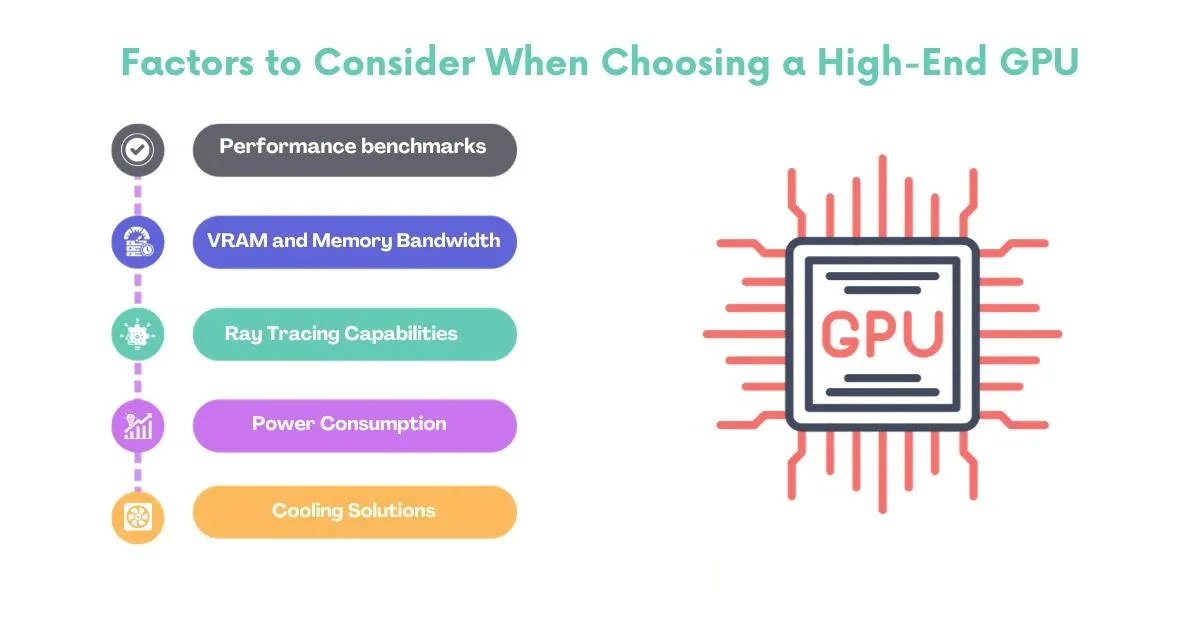
Performance benchmarks
When choosing a high-end GPU, it is crucial to check its performance benchmarks. These benchmarks are based on the overall speed and capability of the GPU. Performance benchmarks give you a measure of how well the GPU performs in various tasks, including gaming, video editing, and other graphics-intensive applications. Higher benchmark scores generally indicate better performance.
VRAM and Memory Bandwidth
VRAM stands for Video Random Access Memory, and it’s the memory dedicated explicitly to handling graphics-related tasks. Think of it as the workspace for your high-end GPU. More VRAM allows the GPUs to handle more extensive and more complex textures, improving performance, especially in high-resolution gaming or content creation. Memory bandwidth is like the data highway that allows quick access to this VRAM, influencing how fast the GPU can process and transfer information.
Ray Tracing Capabilities
Ray Tracing is a technology that simulates how light interacts with objects to create highly realistic lighting and reflections in graphics. A GPU with good ray tracing capabilities can enhance the visual quality of games and other applications, providing a more lifelike and immersive experience.
Power Consumption and Cooling Solutions
Power consumption refers to how much electrical power the GPU requires to operate. It’s essential to consider this factor, especially if you’re conscious of energy efficiency or if you have a specific power supply limit. Cooling solutions are mechanisms designed to keep the GPU at an optimal temperature during operation. Efficient cooling is crucial to prevent overheating, which can affect performance and longevity. Different GPUs come with various cooling solutions, ranging from traditional fans to advanced liquid cooling systems.
List of Best High-End GPUs in 2024
Nvidia RTX 4090
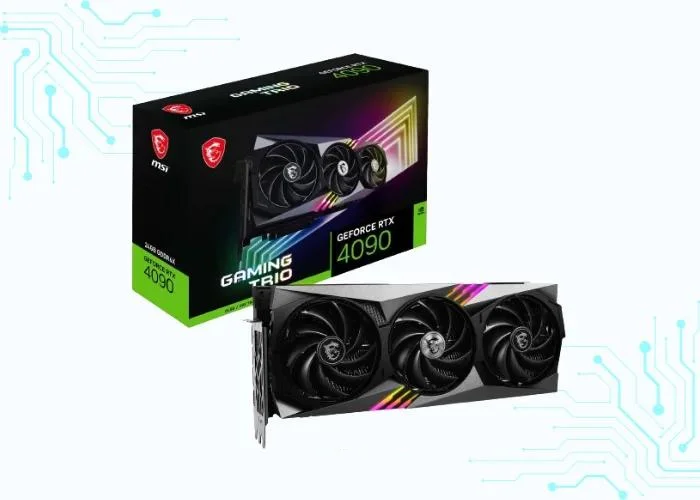
Nvidia RTX 4090 is the top-of-the-line graphics card for gamers and creators. It’s based on the new Ada Lovelace architecture and comes with 24GB of GDDR6X memory. This makes it incredibly powerful and capable of running even the most demanding games and applications at high resolutions and frame rates.
It is a great graphics card for gamers and creators who demand the best performance. However, it’s also one of the most expensive and robust graphics cards on the market. So, if you’re on a budget, you might want to consider a less expensive option.
| Attribute | Specification |
|---|---|
| Chipset | Nvidia RTX 4090 |
| Memory Interface | 384-bit GDDR6X |
| Clock Speed | Base: 2.23 MHz, Boost: 2.52 MHz |
| VRAM | 24 GB GDDR6X |
| Brand and Model | Nvidia RTX 4090 |
| Minimum Power | 850 Watts |
Performance Tests in Various Games
| Game | CPU | Resolution | Graphics Preset | Average FPS |
|---|---|---|---|---|
| CyberPunk | Core-i9 13900K | 3840 x 2160 (4K) | Max | 44 FPS |
| Valorant | Core-i9 13900K | 3840 x 2160 (4K) | Max | 769 FPS |
| Far cry 6 | Core-i9 13900K | 3840 x 2160 (4K) | Max | 126 FPS |
| Grand Theft Auto V | Core-i9 13900K | 3840 x 2160 (4K) | Max | 334 FPS |
| Dota 2 | Core-i9 13900K | 3840 x 2160 (4K) | Max | 241 FPS |
| Call of Duty | Core-i9 13900K | 3840 x 2160 (4K) | Max | 164 FPS |
| Minecraft | Core-i9 13900K | 3840 x 2160 (4K) | Max | 797 FPS |
| Apex Legends | Core-i9 13900K | 3840 x 2160 (4K) | Max | 200 FPS |
| league of legends | Core-i9 13900K | 3840 x 2160 (4K) | Max | 370 FPS |
| Counter-Strike | Core-i9 13900K | 3840 x 2160 (4K) | Max | 346 FPS |
| Forza Horizon 5 | Core-i9 13900K | 3840 x 2160 (4K) | Max | 141 FPS |
| God of War | Core-i9 13900K | 3840 x 2160 (4K) | Max | 146 FPS |
Nvidia RTX 4080
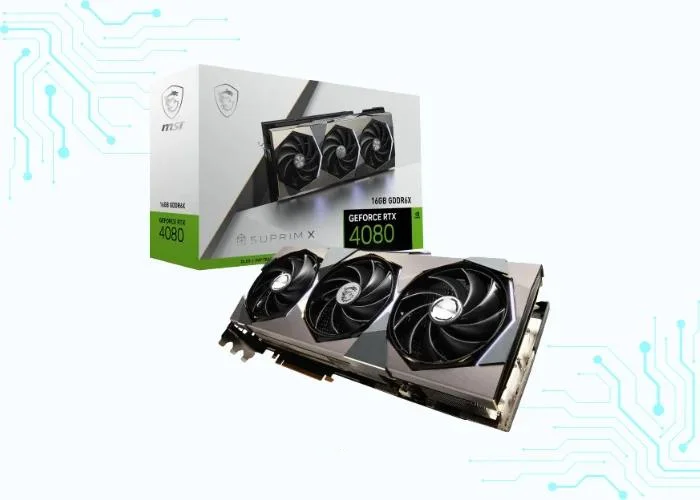
The Nvidia RTX 4080 is a high-end graphics card released in late 2022. It is based on the new Ada Lovelace architecture and offers significant performance improvements over the previous generation RTX 3080.
It is a powerful graphics card that can handle even the most demanding games at high resolution and frame rate. It also supports ray tracing, a technology that simulates realistic lighting effects in games, and The RTX 4080 is also a good choice for creative professionals who need a powerful GPU for tasks such as video editing and 3D rendering.
However, the RTX 4080 is also a costly graphics card. This makes it a poor choice for budget-minded gamers or those who do not need the absolute best performance.
| Attribute | Specification |
|---|---|
| Chipset | Nvidia RTX 4080 |
| Memory Interface | 256-bit GDDR6X |
| Clock Speed | Base clock: 2210 MHz, Boost clock: 2510 MHz |
| VRAM | 16 GB of GDDR6X |
| Brand and Model | Nvidia RTX 4080 |
| Minimum Power | 740 watts |
Performance Tests in Various Games
| Game | CPU | Resolution | Graphics Preset | Average FPS |
|---|---|---|---|---|
| CyberPunk | Core-i9 13900K | 3840 x 2160 (4K) | High | 14 FPS |
| Valorant | Core-i9 13900K | 3840 x 2160 (4K) | High | 676 FPS |
| Far cry 6 | Core-i9 13900K | 3840 x 2160 (4K) | High | 120 FPS |
| Grand Theft Auto V | Core-i9 13900K | 3840 x 2160 (4K) | High | 255 FPS |
| Dota 2 | Core-i9 13900K | 3840 x 2160 (4K) | High | 238 FPS |
| Call of Duty | Core-i9 13900K | 3840 x 2160 (4K) | High | 139 FPS |
| Minecraft | Core-i9 13900K | 3840 x 2160 (4K) | High | 776 FPS |
| Apex Legends | Core-i9 13900K | 3840 x 2160 (4K) | High | 183 FPS |
| league of legends | Core-i9 13900K | 3840 x 2160 (4K) | High | 363 FPS |
| Counter-Strike | Core-i9 13900K | 3840 x 2160 (4K) | High | 333 FPS |
| Forza Horizon 5 | Core-i9 13900K | 3840 x 2160 (4K) | High | 113 FPS |
| God of War | Core-i9 13900K | 3840 x 2160 (4K) | High | 116 FPS |
AMD Radeon RX 7900 XTX
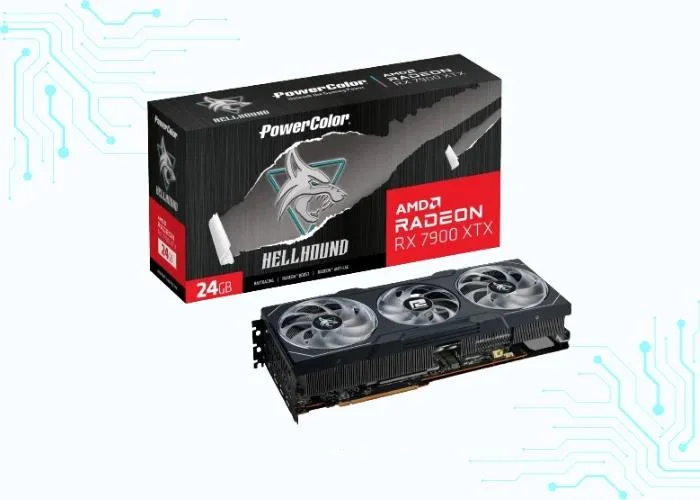
The AMD Radeon RX 7900 XTX is a high-end graphics card released in December 2023 as part of AMD’s RDNA 3 architecture. It’s aimed at the most demanding gamers, offering exceptional performance for ultra-high-resolution resolutions and demanding workloads like ray tracing and AI-powered games.
The AMD Radeon RX 7900 XTX is a powerful graphics card for those who demand the best performance for 4K and beyond gaming. It comes with a premium price tag and high power consumption, making it suitable for enthusiasts and hardcore gamers.
| Attribute | Specification |
|---|---|
| Chipset | AMD Radeon RX 7900 XTX |
| Memory Interface | 384 BIT GDDR6 |
| Clock Speed | Base Clock: 2.3 GHz and Boost Clock: 2.5 GHz |
| VRAM | 24 GB GDDR6 |
| Brand and Model | AMD Radeon RX 7900 XTX |
| Minimum Power | 800 Watts |
Performance Tests in Various Games
| Game | CPU | Resolution | Graphics Preset | Average FPS |
|---|---|---|---|---|
| CyberPunk | Core-i9 13900K | 3840 x 2160 (4K) | High | 21 FPS |
| Valorant | Core-i9 13900K | 3840 x 2160 (4K) | High | 700 FPS |
| Far cry 6 | Core-i9 13900K | 3840 x 2160 (4K) | High | 122 FPS |
| Grand Theft Auto V | Core-i9 13900K | 3840 x 2160 (4K) | High | 272 FPS |
| Dota 2 | Core-i9 13900K | 3840 x 2160 (4K) | High | 240 FPS |
| Call of Duty | Core-i9 13900K | 3840 x 2160 (4K) | High | 146 FPS |
| Minecraft | Core-i9 13900K | 3840 x 2160 (4K) | High | 784 FPS |
| Apex Legends | Core-i9 13900K | 3840 x 2160 (4K) | High | 186 FPS |
| league of legends | Core-i9 13900K | 3840 x 2160 (4K) | High | 365 FPS |
| Counter-Strike | Core-i9 13900K | 3840 x 2160 (4K) | High | 337 FPS |
| Forza Horizon 5 | Core-i9 13900K | 3840 x 2160 (4K) | High | 120 FPS |
| God of War | Core-i9 13900K | 3840 x 2160 (4K) | High | 124 FPS |
Nvidia RTX 4070-Ti

The Nvidia RTX 4070 Ti is a powerful graphics card released in late 2023, alongside its sibling, the RTX 4070. Both cards are built on the new Ada Lovelace architecture and offer significant performance improvements over the previous generation RTX 3070.
It is a beast when it comes to gaming, capable of smoothly running even the most demanding titles at high resolutions and frame rates with all the bells and whistles turned on, including ray tracing for realistic lighting effects. It’s also a great choice for creative professionals who need a powerful GPU for tasks like video editing, 3D rendering, and animation.
| Attribute | Specification |
|---|---|
| Chipset | NVIDIA RTX 4070-Ti |
| Memory Interface | GDDR6X |
| Clock Speed | Base clock: 2.31 GHz, Boost clock: 2.61 GHz |
| VRAM | 12 GB GDDR6X |
| Brand and Model | NVIDIA RTX 4070-Ti |
| Minimum Power | 700 Watts |
Performance Tests in Various Games
| Game | CPU | Resolution | Graphics Preset | Average FPS |
|---|---|---|---|---|
| CyberPunk | Core-i9 13900K | 3840 x 2160 (4K) | High | <10 FPS |
| Valorant | Core-i9 13900K | 3840 x 2160 (4K) | High | 606 FPS |
| Far cry 6 | Core-i9 13900K | 3840 x 2160 (4K) | High | 109 FPS |
| Grand Theft Auto V | Core-i9 13900K | 3840 x 2160 (4K) | High | 211 FPS |
| Dota 2 | Core-i9 13900K | 3840 x 2160 (4K) | High | 227 FPS |
| Call of Duty | Core-i9 13900K | 3840 x 2160 (4K) | High | 117 FPS |
| Minecraft | Core-i9 13900K | 3840 x 2160 (4K) | High | 739 FPS |
| Apex Legends | Core-i9 13900K | 3840 x 2160 (4K) | High | 159 FPS |
| league of legends | Core-i9 13900K | 3840 x 2160 (4K) | High | 359 FPS |
| Counter-Strike | Core-i9 13900K | 3840 x 2160 (4K) | High | 319 FPS |
| Forza Horizon 5 | Core-i9 13900K | 3840 x 2160 (4K) | High | 89 FPS |
| God of War | Core-i9 13900K | 3840 x 2160 (4K) | High | 94 FPS |
Nvidia RTX 3090-Ti

The Nvidia RTX 3090 Ti, released in early 2023, is a behemoth of a graphics card, sitting at the top of the previous generation RTX 30 series pyramid. While it’s now overshadowed by the newer RTX 40 series, it’s still a beast for those looking for raw power and exceptional performance.
It is a monster for 4K and even 8K gaming, able to handle virtually any title thrown at it at high frame rates and maxed-out settings. It’s also great for memory-intensive tasks like video editing, 3D rendering, and scientific computing, thanks to its massive 24GB of GDDR6X memory.
| Attribute | Specification |
|---|---|
| Chipset | GA102-350-KD-A1 |
| Memory Interface | 384-bit GDDR6X |
| Clock Speed | Base: 1560 MHz, Boost: 1860 MHz |
| VRAM | 24 GB GDDR6X |
| Brand and Model | Nvidia GeForce RTX 3090 Ti |
| Minimum Power | 850 Watts |
Performance Tests in Various Games
| Game | CPU | Resolution | Graphics Preset | Average FPS |
|---|---|---|---|---|
| CyberPunk | Core-i9 13900K | 3840 x 2160 (4K) | High | <10 FPS |
| Valorant | Core-i9 13900K | 3840 x 2160 (4K) | High | 593 FPS |
| Far cry 6 | Core-i9 13900K | 3840 x 2160 (4K) | High | 107 FPS |
| Grand Theft Auto V | Core-i9 13900K | 3840 x 2160 (4K) | High | 203 FPS |
| Dota 2 | Core-i9 13900K | 3840 x 2160 (4K) | High | 225 FPS |
| Call of Duty | Core-i9 13900K | 3840 x 2160 (4K) | High | 112 FPS |
| Minecraft | Core-i9 13900K | 3840 x 2160 (4K) | High | 731 FPS |
| Apex Legends | Core-i9 13900K | 3840 x 2160 (4K) | High | 153 FPS |
| league of legends | Core-i9 13900K | 3840 x 2160 (4K) | High | 358 FPS |
| Counter-Strike | Core-i9 13900K | 3840 x 2160 (4K) | High | 316 FPS |
| Forza Horizon 5 | Core-i9 13900K | 3840 x 2160 (4K) | High | 84 FPS |
| God of War | Core-i9 13900K | 3840 x 2160 (4K) | High | 89 FPS |
Nvidia RTX 3080-Ti
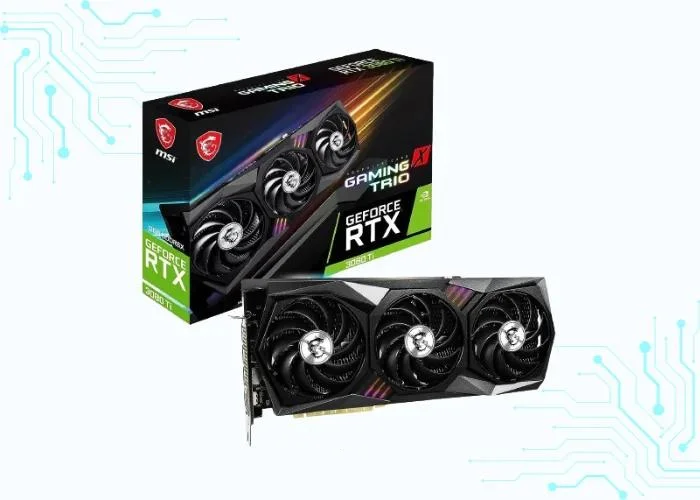
The Nvidia RTX 3080 Ti, launched in June 2021, was a powerful graphics card that still packs a punch even with the newer RTX 40 series around. It falls between the RTX 3080 and the mighty RTX 3090 in terms of performance and price, making it a compelling option for those seeking a balance between top-tier capabilities and cost.
It delivers fantastic performance for 4K gaming, offering smooth gameplay and stunning visuals in demanding titles. It also excels at 1440p and 1080p gaming, pushing high frame rates for a butter-smooth experience. Its 12GB of GDDR6X memory makes it suitable for memory-intensive tasks like video editing and 3D rendering, though not quite as adept as the RTX 3090 Ti with its 24GB.
| Attribute | Specification |
|---|---|
| Chipset | Nvidia GA102-225-A1 |
| Memory Interface | 384-bit GDDR6X |
| Clock Speed | Base: 1365 MHz, Boost: 1665 MHz |
| VRAM | 12 GB GDDR6X |
| Brand and Model | Nvidia GeForce RTX 3080 Ti |
| Minimum Power | 750 watts |
Performance Tests in Various Games
| Game | CPU | Resolution | Graphics Preset | Average FPS |
|---|---|---|---|---|
| CyberPunk | Core-i9 13900K | 3840 x 2160 (4K) | High | <10 FPS |
| Valorant | Core-i9 13900K | 3840 x 2160 (4K) | High | 562 FPS |
| Far cry 6 | Core-i9 13900K | 3840 x 2160 (4K) | High | 102 FPS |
| Grand Theft Auto V | Core-i9 13900K | 3840 x 2160 (4K) | High | 188 FPS |
| Dota 2 | Core-i9 13900K | 3840 x 2160 (4K) | High | 218 FPS |
| Call of Duty | Core-i9 13900K | 3840 x 2160 (4K) | High | 102 FPS |
| Minecraft | Core-i9 13900K | 3840 x 2160 (4K) | High | 710 FPS |
| Apex Legends | Core-i9 13900K | 3840 x 2160 (4K) | High | 141 FPS |
| league of legends | Core-i9 13900K | 3840 x 2160 (4K) | High | 356 FPS |
| Counter-Strike | Core-i9 13900K | 3840 x 2160 (4K) | High | 309 FPS |
| Forza Horizon 5 | Core-i9 13900K | 3840 x 2160 (4K) | High | 72 FPS |
| God of War | Core-i9 13900K | 3840 x 2160 (4K) | High | 79 FPS |
AMD RX 6950-XT
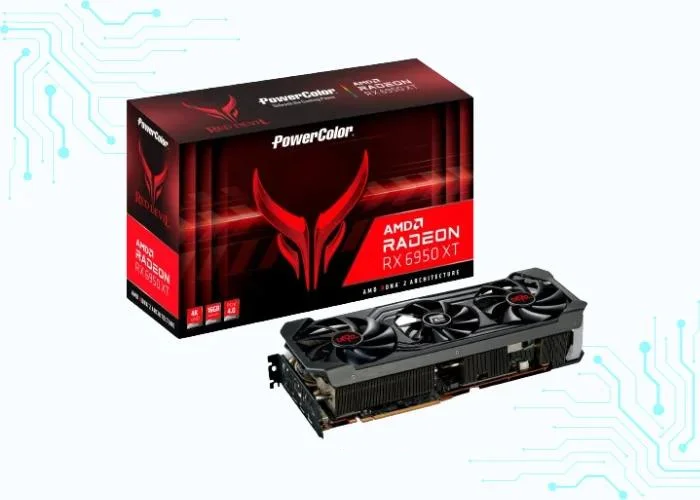
The AMD RX 6950 XT is a high-end graphics card released in late 2022, boasting the powerful RDNA 2 architecture and offering impressive performance for gamers and creators alike.
It is a powerhouse for 4K gaming, delivering smooth gameplay and stunning visuals in even the most demanding titles. It also excels at 1440p and 1080p gaming, pushing high-frame rates for a buttery-smooth experience. Additionally, its 16GB of GDDR6 memory makes it well-suited for memory-intensive tasks like video editing and 3D rendering.
| Attribute | Specification |
|---|---|
| Chipset | AMD RX 6950-XT |
| Memory Interface | 256-bit |
| Clock Speed | Base: 1860 MHz, Boost: 2310 MHz |
| VRAM | GB GDDR6 |
| Brand and Model | AMD Radeon RX 6950-XT |
| Minimum Power | 850 Watts |
Performance Tests in Various Games
| Game | CPU | Resolution | Graphics Preset | Average FPS |
|---|---|---|---|---|
| CyberPunk | Core-i9 13900K | 3840 x 2160 (4K) | High | <10 FPS |
| Valorant | Core-i9 13900K | 3840 x 2160 (4K) | High | 590 FPS |
| Far cry 6 | Core-i9 13900K | 3840 x 2160 (4K) | High | 107 FPS |
| Grand Theft Auto V | Core-i9 13900K | 3840 x 2160 (4K) | High | 202 FPS |
| Dota 2 | Core-i9 13900K | 3840 x 2160 (4K) | High | 224 FPS |
| Call of Duty | Core-i9 13900K | 3840 x 2160 (4K) | High | 111 FPS |
| Minecraft | Core-i9 13900K | 3840 x 2160 (4K) | High | 729 FPS |
| Apex Legends | Core-i9 13900K | 3840 x 2160 (4K) | High | 153 FPS |
| league of legends | Core-i9 13900K | 3840 x 2160 (4K) | High | 358 FPS |
| Counter-Strike | Core-i9 13900K | 3840 x 2160 (4K) | High | 316 FPS |
| Forza Horizon 5 | Core-i9 13900K | 3840 x 2160 (4K) | High | 83 FPS |
| God of War | Core-i9 13900K | 3840 x 2160 (4K) | High | 88 FPS |
AMD RX 6900-XT
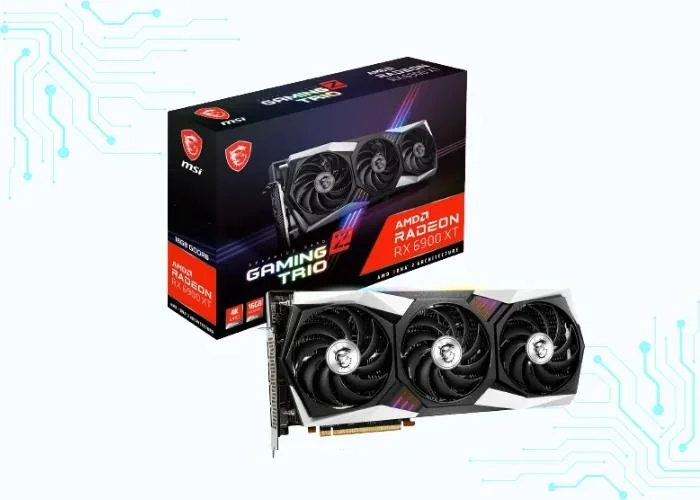
The AMD RX 6900 XT, launched in late 2020, was a flagship graphics card in its era and still offers respectable performance in 2024. It sits just below the RX 6950 XT in AMD’s RDNA 2 lineup, packing a punch for high-resolution gaming and creative tasks.
It excels at 4K gaming, delivering smooth gameplay and impressive visuals in most titles. While not quite as powerful as the newer RX 6950 XT, it still holds its own at 1440p and 1080p, achieving high frame rates for a silky-smooth experience. Its 16GB of GDDR6 memory makes it suitable for memory-intensive tasks like video editing and 3D rendering.
| Attribute | Specification |
|---|---|
| Chipset | AMD Radeon RX 6900-XT |
| Memory Interface | 256-bit GDDR6 |
| Clock Speed | Up to 2015 MHz |
| VRAM | 16 GB |
| Brand and Model | AMD RX 6900-XT |
| Minimum Power | 300 watts |
Performance Tests in Various Games
| Game | CPU | Resolution | Graphics Preset | Average FPS |
|---|---|---|---|---|
| CyberPunk | Core-i9 13900K | 3840 x 2160 (4K) | High | <10 FPS |
| Valorant | Core-i9 13900K | 3840 x 2160 (4K) | High | 578 FPS |
| Far cry 6 | Core-i9 13900K | 3840 x 2160 (4K) | High | 105 FPS |
| Grand Theft Auto V | Core-i9 13900K | 3840 x 2160 (4K) | High | 196 FPS |
| Dota 2 | Core-i9 13900K | 3840 x 2160 (4K) | High | 221 FPS |
| Call of Duty | Core-i9 13900K | 3840 x 2160 (4K) | High | 107 FPS |
| Minecraft | Core-i9 13900K | 3840 x 2160 (4K) | High | 721 FPS |
| Apex Legends | Core-i9 13900K | 3840 x 2160 (4K) | High | 148 FPS |
| league of legends | Core-i9 13900K | 3840 x 2160 (4K) | High | 357 FPS |
| Counter-Strike | Core-i9 13900K | 3840 x 2160 (4K) | High | 313 FPS |
| Forza Horizon 5 | Core-i9 13900K | 3840 x 2160 (4K) | High | 78 FPS |
| God of War | Core-i9 13900K | 3840 x 2160 (4K) | High | 85 FPS |
AMD Radeon RX 7800 XT

The AMD Radeon RX 7800 XT is a high-end graphics card released in September 2023. It is based on the RDNA 3 architecture and is positioned as a 1440p gaming card, although it can also handle 4K gaming at some settings.
It is a great choice for gamers who are looking for a high-performance graphics card that can handle 1440p and 4K gaming. It is also a good option for gamers who want to take advantage of new features like ray tracing and AMD FidelityFX Super Resolution.
| Attribute | Specification |
|---|---|
| Chipset | AMD Radeon RX 7800 XT |
| Memory Interface | 256-Bit GDDR6 |
| Clock Speed | (Base) 2124 MHz, (Boost) 2430 MHz |
| VRAM | 16 GB GDDR6 |
| Brand and Model | AMD Radeon RX 7800 XT |
| Minimum Power | 700 Watts |
Performance Tests in Various Games
| Game | CPU | Resolution | Graphics Preset | Average FPS |
|---|---|---|---|---|
| CyberPunk | Core-i9 13900K | 3840 x 2160 (4K) | Max | <10 FPS |
| Valorant | Core-i9 13900K | 3840 x 2160 (4K) | Max | 566 FPS |
| Far cry 6 | Core-i9 13900K | 3840 x 2160 (4K) | Max | 102 FPS |
| Grand Theft Auto V | Core-i9 13900K | 3840 x 2160 (4K) | Max | 190 FPS |
| Dota 2 | Core-i9 13900K | 3840 x 2160 (4K) | Max | 219 FPS |
| Call of Duty | Core-i9 13900K | 3840 x 2160 (4K) | Max | 104 FPS |
| Minecraft | Core-i9 13900K | 3840 x 2160 (4K) | Max | 713 FPS |
| Apex Legends | Core-i9 13900K | 3840 x 2160 (4K) | Max | 143 FPS |
| league of legends | Core-i9 13900K | 3840 x 2160 (4K) | Max | 357 FPS |
| Counter-Strike | Core-i9 13900K | 3840 x 2160 (4K) | Max | 310 FPS |
| Forza Horizon 5 | Core-i9 13900K | 3840 x 2160 (4K) | Max | 74 FPS |
| God of War | Core-i9 13900K | 3840 x 2160 (4K) | Max | 81 FPS |
Nvidia RTX 4060

The Nvidia RTX 4060 is a graphics card (GPU) based on the new Ada Lovelace architecture, released in late 2023. It’s positioned as a mid-range option within the RTX 40 series, offering solid performance for 1080p and 1440p gaming, along with capabilities for creative work and content creation.
It is a high-end GPU well-suited for demanding gamers and creative professionals. It offers excellent performance, cutting-edge features, and versatility for both gaming and creative work. However, it’s also a more expensive option compared to mid-range GPUs.
| Attribute | Specification |
|---|---|
| Chipset | Nvidia RTX 4060 |
| Memory Interface | 128-bit memory interface |
| Clock Speed | (Base) 1,830 MHz, (Boost) 2,460 MHz |
| VRAM | 8 GB of GDDR6 VRAM |
| Brand and Model | Nvidia RTX 4060 |
| Minimum Power | 110 Watts |
Performance Tests in Various Games
| Game | CPU | Resolution | Graphics Preset | Average FPS |
|---|---|---|---|---|
| CyberPunk | Core-i9 13900K | 3840 x 2160 (4K) | Max | <10 FPS |
| Valorant | Core-i9 13900K | 3840 x 2160 (4K) | Max | 421 FPS |
| Far cry 6 | Core-i9 13900K | 3840 x 2160 (4K) | Max | 70 FPS |
| Grand Theft Auto V | Core-i9 13900K | 3840 x 2160 (4K) | Max | 137 FPS |
| Dota 2 | Core-i9 13900K | 3840 x 2160 (4K) | Max | 176 FPS |
| Call of Duty | Core-i9 13900K | 3840 x 2160 (4K) | Max | 52 FPS |
| Minecraft | Core-i9 13900K | 3840 x 2160 (4K) | Max | 591 FPS |
| Apex Legends | Core-i9 13900K | 3840 x 2160 (4K) | Max | 70 FPS |
| league of legends | Core-i9 13900K | 3840 x 2160 (4K) | Max | 349 FPS |
| Counter-Strike | Core-i9 13900K | 3840 x 2160 (4K) | Max | 275 FPS |
| Forza Horizon 5 | Core-i9 13900K | 3840 x 2160 (4K) | Max | 17 FPS |
| God of War | Core-i9 13900K | 3840 x 2160 (4K) | Max | 34 FPS |
Overclocking and Cooling Solutions
Overclocking and Cooling Solutions are crucial aspects of maximizing the performance of cooling systems. Let’s explore the pros and cons of overclocking:
Importance of Cooling Systems
The performance of a GPU is directly tied to how efficiently it manages heat. As a GPU works harder, it generates more heat, and without proper cooling, it can lead to thermal throttling, reducing performance and potentially damaging the hardware.
Why Cooling System Matter:
- Temperature Regulation: Cooling systems, such as fans or liquid cooling solutions, help maintain optimal operating temperature for the GPU.
- Preventing Thermal Throttling: Effective cooling prevents the GPU from reaching a temperature where it automatically reduces its performance to avoid damage.
- Extended Lifespan: Lower temperatures contribute to the longevity of the GPU by reducing wear and tear on the components.
A reliable cooling system is essential for ensuring that your high-end GPU operates at peak performance without risking overheating.
Pros and Cons of Overclocking
Overclocking involves pushing the GPU beyond its factory-set specification to achieve higher clock speeds, and, consequently, better performance. However, it comes with both advantages and drawbacks.
Pros of Overclocking:
- Increased Performance: Overclocking can lead to higher frame rates and improved performance in graphics-intensive tasks.
- Cost-Effective Boost: Instead of upgrading to a new GPU, overclocking allows users to squeeze more performance out of their existing hardware.
- Customization: Overclocking generates more heat, necessitating better cooling solutions to prevent overheating.
- Extend Hardware Lifespan: A moderate overclock can sometimes keep your older hardware competitive with newer models for a longer period, allowing you to delay an upgrade.
- Technical Satisfaction: For tech-savvy users, the process of overclocking can be a rewarding experience, offering a sense of accomplishment and a deeper understanding of your hardware.
Cons of Overclocking:
- Heat generation: Overclocking generates more heat, necessitating better cooling solutions to prevent overheating.
- Potential Instability: Pushing the GPU beyond its limits can lead to system instability, crashes, or even hardware damage.
- Voiding Warranty: Overclocking often voids the manufacturer’s warranty, leaving users responsible for any potential damage.
How new technologies impact GPU choices
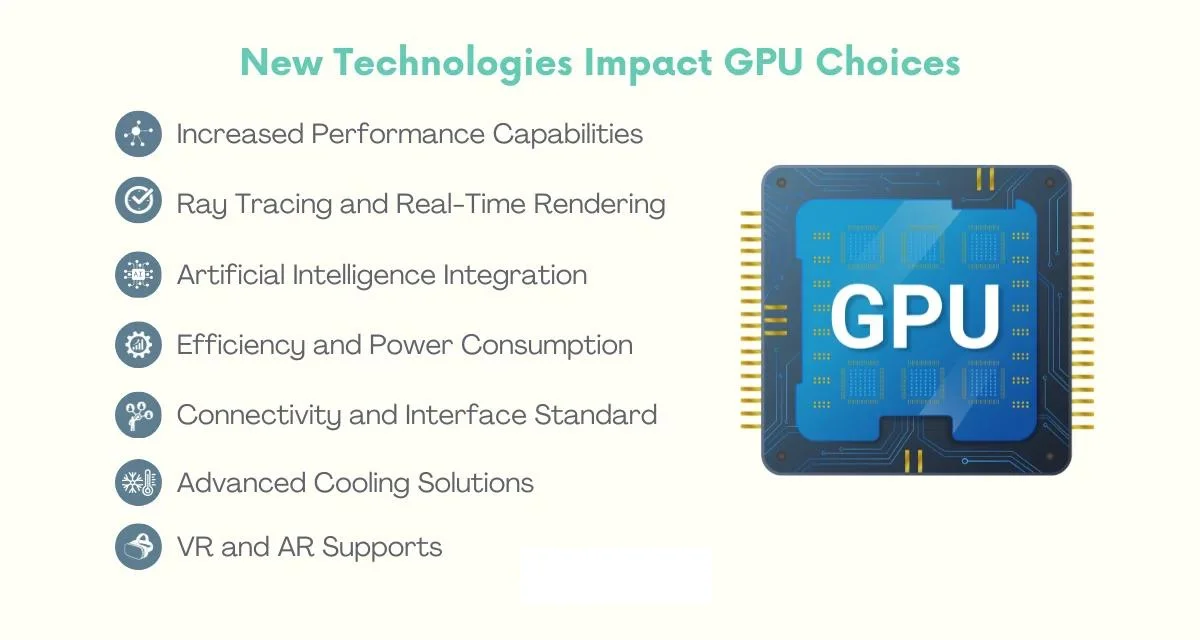
As technology advances at a rapid pace, the landscape of graphics processing units (GPUs) is continually evolving, and understanding how new technologies impact GPU choices is crucial. Let’s delve into the ways emerging technologies influence the selection of GPUs:
Increased Performance Capabilities:
New technologies often bring about improved performance capabilities in GPUs. Whether it’s advancements in architecture, faster memory technologies, or more efficient processing units, these enhancements result in GPUs that can handle more demanding tasks, such as high-resolution gaming, complex simulations, and resource-intensive content creation.
Ray Tracing and Real-Time Rendering:
Ray tracing, a technology simulating the way light interacts with virtual objects, has become a game-changer in the graphics industry. GPUs equipped with ray tracing capabilities provide a more realistic visual experience in games and applications. As this technology evolves, users seeking cutting-edge graphics often prioritize GPUs that excel in real-time rendering.
Artificial Intelligence Integration:
The integration of artificial intelligence (AI) into GPUs has opened new possibilities. AI-enhanced features, such as deep learning super sampling (DLSS) in gaming, contribute to improved image quality and performance. GPUs with dedicated AI cores or tensor cores are increasingly sought after for applications that leverage machine learning and AI algorithms.
Efficiency and Power Consumption:
New technologies frequently focus on improving efficiency and reducing power consumption. Energy-efficient GPUs not only contribute to a more environmentally friendly computing experience but also lead to less heat generation and quieter operation. Users, especially those conscious of energy consumption, may prioritize GPUs that offer a balance between performance and efficiency.
Connectivity and Interface Standard:
Evolving connectivity standards, such as PCIe (Peripheral Component Interconnect Express), impact the data transfer speed between GPUs and other components in a computer. GPUs compatible with the latest interface standards ensure optimal communication with the rest of the system, enhancing overall performance.
Advanced Cooling Solutions:
The introduction of new cooling technologies plays a role in GPU choices. Efficient cooling solutions, including innovative fan designs, liquid cooling systems, and heat dissipation methods, contribute to maintaining optimal operating temperatures. Users may consider GPUs with advanced cooling solutions for improved longevity and sustained performance.
VR (Virtual Reality) and AR (Augmented Reality) support:
GPUs that support virtual and augmented reality applications are gaining prominence. As these technologies become more mainstream, users interested in immersive experiences seek GPUs that can deliver smooth and responsive VR and AR content.
Tips for Optimizing GPU Performance

Optimizing GPU performance involves a combination of software tweaks and maintenance practices to ensure that your high-end graphics card operates at its best. Let’s explore these aspects in detail:
Software Tweaks
- Driver Updates: Regularly update your GPU drivers to access performance improvements, bug fixes, and compatibility enhancements with the latest software.
- Optimized Settings: Adjust in-game settings to find the right balance between graphical fidelity and performance. Lowering certain settings can significantly improve frame rates.
- GPU Management Software: Utilize manufacturer-provided GPU management software to fine-tune settings. These tools often allow customization of clock speed, fan profiles, and power settings.
- Resolution and Scaling: Experiment with different resolutions and scaling options. Lowering the resolution can boost performance, especially in resource-intensive applications.
- Background Applications: Close unnecessary background applications to free up system resources. This ensures that the GPU can focus on the primary task at hand without unnecessary load.
Maintenance Practices
- Dust Management: Regularly clean the GPU and its surrounding components to prevent dust buildup. Dust can act as an insulator, leading to increased temperatures and reduced cooling efficiency.
- Cooling System Check: Ensure that the cooling system is functioning optimally. Check for any malfunctioning fans or cooling components. Upgrading to more efficient cooling solutions can also be beneficial.
- Proper Ventilation: Ensure that your computer case has proper ventilation. Good airflow helps dissipate heat effectively and prevents components from overheating.
- Monitor Temperatures: Use monitoring software to keep an eye on GPU temperatures. If temperatures consistently run too high, consider adjusting settings or upgrading cooling solutions.
- Power Supply Considerations: Ensure that your power supply unit (PSU) provides sufficient and stable power to the GPU. Inadequate power can lead to performance issues or system instability.
- Regular System Maintenance: Conduct routine maintenance on your entire system, including software updates, antivirus scans, and disk cleanup. A well-maintained system is more likely to run optimally.
FAQs
What factors should I prioritize when choosing a high-end GPU?
Prioritize factors such as performance, compatibility with your system, and whether you’ll be using the GPU for gaming or professional tasks. Consider your specific needs and budget.
Are there any upcoming GPU releases that I should wait for in 2024?
While it’s challenging to predict future releases, keeping an eye on industry announcements and news can provide insights into potential upcoming GPUs. Consider your urgency and current market offering.
How does the environmental impact of GPUs factor into my decision?
Environmental impact is an important consideration. Look for eco-friendly GPU options or those with sustainability initiatives. Consider the energy efficiency and manufacturing practices of the GPU you choose.
Can I use a gaming GPU for professional tasks, and vice versa?
Gaming GPUs can often handle professional tasks and vice versa, but specific requirements may vary. Consider the software applications you use and research whether the GPU is optimized for your intended tasks.
What are the potential drawbacks of overclocking my GPU?
Overclocking can lead to increased heat generation and potential system instability and may void the manufacturer’s warranty. It requires careful consideration of cooling solutions and an understanding of the risks involved.
How often should I update my GPU drivers for optimal performance?
Regularly updating GPU drivers is advisable, especially when new updates offer performance improvements, bug fixes, or enhanced compatibility with the latest software. Check for updates periodically or when you encounter issues.
What role does VRAM play in GPU performance, and how much do I need?
Video Random Access Memory (VRAM) is crucial for storing graphical data. The amount you need depends on your usage; for gaming at higher resolutions or engaging in graphics-intensive tasks, a GPU with more VRAM is beneficial.
Conclusion
In conclusion, selecting the optimal high-end GPU in 2024 demands a nuanced approach. Navigating through the evolving GPU landscape involves considering performance metrics, compatibility, and the delicate balance between gaming and professional use.
Reviews, price-to-performance ratios, and user experiences provide valuable insights. Overclocking, coupled with efficient cooling, enhances capabilities but necessitates careful management.
Future considerations include sustainability, eco-friendly options, and performance optimization tips. As the GPU market advances, staying informed about upcoming releases and technological trends becomes paramount.
Ultimately, the choice hinges on individual needs, ensuring a tailored and seamless computing experience for both gaming enthusiasts and professionals.





Leave a Reply